A frieze is a horizontal set of decorations on a building (this picture of a frieze comes from http://en.wikipedia.org/wiki/Frieze )
A mathematical frieze pattern is a geometric pattern that has a horizontal (left to right) format.
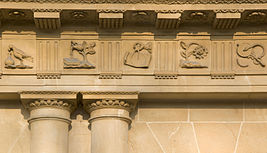
Some patterns have transformations and symmetry in them. When mathematicians study patterns like this, they call them Frieze patterns.
A frieze is a horizontal set of decorations on a building (this picture of a frieze comes from http://en.wikipedia.org/wiki/Frieze ) A mathematical frieze pattern is a geometric pattern that has a horizontal (left to right) format. |
 |
In elementary school, we mostly work on identifying the transformations in a geometric pattern and in figuring out how to continue a pattern. Here are some patterns I made, and some of the transformations you can find in them:
Slides: This pattern has only slides in it. It's a really simple pattern--if you gave it a name like we use for repeating patterns, it would be just an "A" pattern, because it repeats the same shape (spiral) over and over, just slid to the right.
 |
|
Flips: These patterns have flips as well as slides.
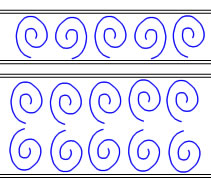 |
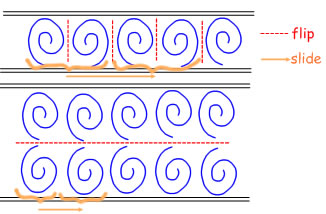 |
The top pattern has reflections across vertical lines, and the bottom pattern has reflections across horizontal lines. One of the rules for making a pattern like this is that it has to eventually repeat (or it doesn't count as a frieze pattern), so all of these patterns have slides. Some of them you have to put into larger chunks before you slide over to make them repeat.
Turns: These three patterns all have turns.
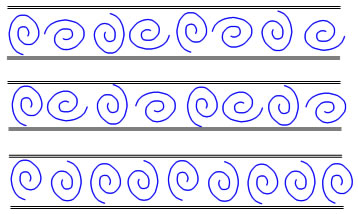 |
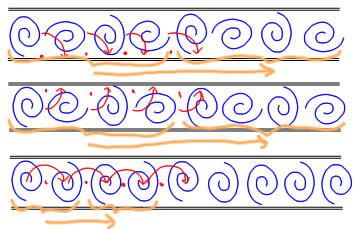 |
In the top pattern, each spiral is turned by 1/4 turn clockwise to get the next spiral.
In the middle pattern, each spiral is turned by 1/4 turn counterclockwise to get the next spiral.
In the last pattern, each spiral is turned by 1/2 turn to get the next spiral.
Figuring out where the center of rotation is to move one spiral to the next is a pretty tricky thing to do (definitely a higher grade level skill!), but seeing that you can get from one to the next by making a 1/2 turn or a 1/4 turn (without being specific about the center of rotation) is a lot easier, and is sometimes a grade 3 question.
These patterns are definitely the kind of thing that are used for third grade transformation patterns if the goal is to figure out and continue the sequence.
A typical question: draw what comes next in this pattern:
|
How to solve it: notice that each "F" is turned by 1/4 turn clockwise. Draw the next F:
|
There are more variations you can make with different combinations of turns, flips and slides:
This pattern has both horizontal and vertical flips, and it has half-turns (where the centers of rotation are where the symmetry lines intersect)
|
This pattern has a combination of flips and slides called a glide reflection
|
As a third grade skill, children can find some of the transformations in patterns like this, and they can use tranformations and symmetry to continue a pattern that has been started that uses transformations to make the pattern.
As a middle grades skill, children can find more of the transformations, and they can describe them more exactly.
Mathematicians think about ways to put patterns like these into categories depending on how the transformations interact with each other. An interesting fact is that mathematicians have figured out that you can put any kind of frieze pattern into one of 7 categories that describes what sorts of symmetries the pattern has. If you look up Frieze patterns, you can find out more about these categories, and you can find some cool and artistic examples of these patterns.
If you're making up patterns for children to figure out and follow, make sure you start with a shape that doesn't already have symmetry (otherwise you'll get lots of extra symmetry you hadn't planned on!), and you should pick a shape that's easy to draw. My spirals were great for me because I could get SMART Notebook to make lots of identical copies of my first spiral. When I came up with an example for children to draw, though, you'll notice that I switched to the letter F--it's a lot easier to write an F sideways than it is to get a spiral to come out just right when you're drawing it, so make sure you start with a shape that's not too tricky to draw too!